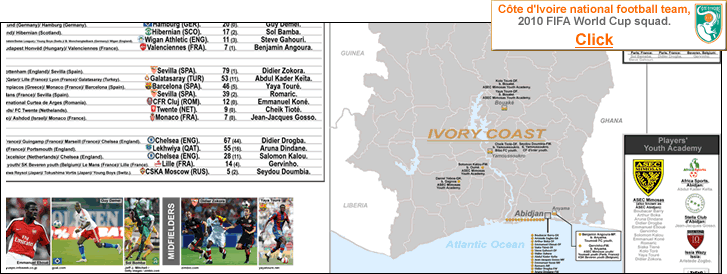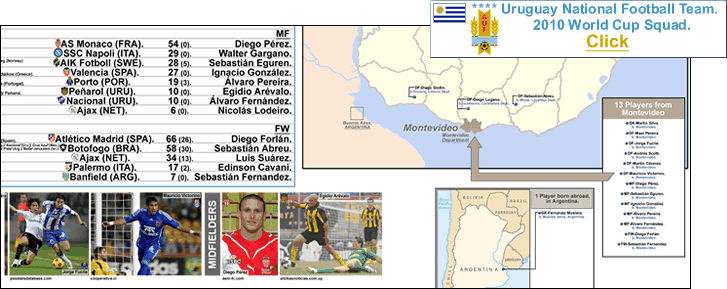 .
.
Uruguay World Cup squad.
The map shows the Uruguay national football team which competed in the 2010 World Cup in South Africa.
-
At the bottom, left on the map page are photos of all the players on the Uruguay team that have seen action in Uruguay’s first 6 matches in the 2010 World Cup (21 player photos, all in the gear of their professional clubs). International appearances (aka caps) and international goals are listed and are up to date as of 6th July, 2010.
…
13 players in the squad were born in Montevideo. Montevideo is Uruguay’s sole city of over 100,000 inhabitants. Montevideo’s population is around 1.3 million {2004 figure}. Two of the three players who have scored for Uruguay in their first 4 games in this World Cup come from Montevideo…FW Diego Forlán and MF Alváro Pereira. Forlán, who scored the winning goal for Atlético Madrid in their Europa League finals win over Fulham in May, scored two goals in the 16th June match v. South Africa (which ended 3-0). Attacking midfielder Alváro Pereira, who plays for FC Porto in Portugal, also scored in the match versus South Africa, in extra time, heading in a cross from Luis Suarez (see below).
…
Salto and Paysandú which produced 2 and 3 players in the squad, respectively, both have populations in the upper 90,000s (Salto is slightly larger). Both these cities are in the west of the country, on the east bank of the Uruguay River, which borders Argentina’s Entre Rios Province. Prolific goal scoring striker Luis Suárez, who plays professionally for Ajax of the Netherlands, is from Salto. In this World Cup, Suárez has maintained his amazing production rate (he has scored 89 goals in 131 games in the Dutch Eredivisie). Suárez scored the winner in Uruguay’s 1-0 defeat of Mexico, then scored both goals in Uruguay’s victory over South Korea.
…
Uruguay itself has a population of only around 3.4 million (2009 estimate}.
-
Thanks to the contributors to the pages at en.wikipedia.org, Uruguay national football team. Thanks to UK Soccer Shop, for the photos of the Uruguay jerseys.
June 29, 2010
2010 World Cup: Uruguay, 23-man roster.
June 26, 2010
2010 FIFA World Cup: Paraguay, 23-man roster.
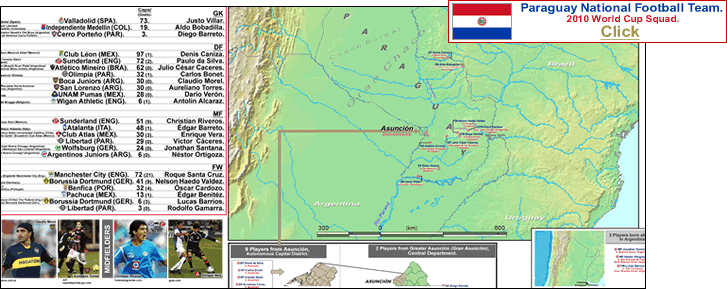
Paraguay World Cup squad.
The map shows the birthplaces of the players on the Paraguay national football team which competed in the 2010 World Cup in South Africa.
At the bottom, left of the map page are all the players on the Paraguay team who saw action in Paraguay’s 5 matches in the 2010 World Cup (20 player photos, all in the gear of the players’ professional clubs). International appearances (aka caps) and international goals are up to date as of 3rd July, 2010 (that is, after Paraguay exited the 2010 World Cup in the Quarterfinals).
-
Asunción is the capital and only large city in Paraguay, with a city population of around 680,000, and a metro-area population of around 1.87 million {2009 figures}. Paraguay itself has a population of around 6.3 million. Paraguay is one of only two land-locked nations in South America (the other being Bolivia).
The most important geographic characteristic of Paraguay is the contrast between the two major regions in the country, Oriental Paraguay and Occidental Paraguay (ie, East and West Paraguay). The two regions are divided by the Rio Paraguay, which is a tributary of the mighty Rio Paraná (which empties into the Atlantic between Argentina and Uruguay). Western Paraguay is a dry and barren region that is part of the Gran Chaco, which stretches from north-central Argentina, through western Paraguay and into Bolivia and a small section of Brazil. Over 90% of Paraguayans live in the eastern half of the country, which is also called the Paraneña region. The eastern half of Paraguay boasts fertile land and agriculture dominates the economy and it’s total exports (soybearn production and exports have skyrocketed in recent years). Yet to this day, thousands of Paraguayans still rely on subsistence farming to survive. Urban unemployment has always been a problem in Paraguay.
But what the country has going for it is vast hydroelectric power reserves. Paraguay relies almost entirely on hydroelectric power, and exports large quantities. Paraguay is the world’s second-largest exporter of electricity {France is first, see this list}. The Itaipú Dam, just upstream from the spectacular Iguazu Falls, is jointly run with Brazil, and has the world’s second-largest generating capacity. Another dam in the south of Paraguay (the Yacyretá) is jointly run with Argentina. These two dams’ and the Iguazu Falls’ locations are shown on the map.
…
Paraguay is a bilingual country…it’s two official languages are Spanish and Guaraní. [The Guaraní were the indigenous peoples that lived in the regions now known as Paraguay and also parts of southern Brazil, Bolivia, and Argentina.] Around 95% of Paraguayans are of mestizo (or mixed) race, the majority being a mix between European and Guaraní. An interesting fact is that the Paraguay national football team takes advantage of this, when playing other Spanish-speaking teams…during matches they speak to each other in Guaraní so their opponents don’t pick up their strategy.
-
20 players in the Paraguay squad were born in Eastern Paraguay, and zero players were born in the Chaco. 3 players were born in Argentina, including two who have seen action in the 2010 World Cup…FW Jonathan Santana (who plays professionally for Wolfsburg, the 2009 German champion), and FW Lucas Barrios (who scored 19 goals for German club Borussia Dortmund in 2009-10). [The Paraguay coach, Gerado Martino, is also an Argentine.]
…
9 players were born in the city of Asunción, including talismanic striker Roque Santa Cruz (of Manchester City), with 2 more players coming from Greater Asunción (Gran Asunción), including midfieder and playmaker Christian Riveros (who was signed by Sunderland in May, 2010).
Other Asunción-born players who have started, or seen action, in the 2010 World Cup are… DF Paulo da Silva (also of Sunderland), DF Claudio Morel (of Argentine giants Boca Juniors), DF Aureliano Torres (who also plays in Argentina, for San Lorenzo), MF Édgar Barreto (of Italian top-flight minnows Atalanta), MF Enrique Vera (of Club Atlas of Guadalajara, Mexico), MF Victor Cáceres (who plays for Paraguayan giants Libertad), and another player who plays professionally in Paraguay: DF Carlos Bonet, who plys his trade with the most sucessful Paragauyan football club, Olimpia (who have won the most Paraguayan titles, 38, as well as 3 Copa Libertadores titles, the last in 2002).
…
4 players were born in Caaguazú Department (I highlighted Caaguazú Department in pale white on the map). All four of these Caaguazú-born players have either started or seen action in the 2010 World Cup…FW Nelson Haedo Valdez (who also plays for Borussia Dortmund), FW Óscar Cardozo (who plays in Portugal for Benfica), FW Édgar Benitez (who plays for the internationally successful Mexican club Pachuca), and DF Júlio César Cacerés (who is signed with Brazil’s Atlético Mineiro).
…
2 players were born in Amambay Department, which is in north-central Paraguay and borders Brazil, including DF Denis Caniza, who is the most-capped player and team captain. Caniza now plays for Club Léon, a second division Mexican club.
…
3 players come from departments south of Asunción. One of these players is a starter, GK Justo Villar (of just-relegated Spanish club Valladolid). Villar was born in Cerrito, Ñeembucú Department, which is on the Rio Paraña, just downstream from the Yacyretá Dam, and on the border with Argentina. DF Antolín Alcaraz, born in San Roque Gonzalez, Paraguarí Department, saw action in 3 matches; in May, 2010, Alcaraz was sold by the Belgian Club Brugge to England’s Wigan Athletic. DF Dario Verón, born in San Ignacío, Misiones Department, saw action in Paraguay’s final match, versus Spain. Verón plays for Mexoico’s Pumas de UNAM.
-
Thanks to the contributors to the pages at en.wikipedia.org, Paraguay national football team.
Thanks to Big Soccer.com, for the photos of the Paraguay jerseys.
Thanks to Demis.nl, for the Paraguay base map, Demis Web Map Server.
June 23, 2010
2010 FIFA World Cup: Mexico, 23-man roster.
Mexico World Cup squad.
The map shows the Mexico national football team which is competing in the 2010 World Cup in South Africa.
At the bottom of the map page are photos of starters and key subs (18 player photos). International appearances (aka caps) and goals are listed, and are up to date as of 27 June, 2010.
-
Thanks to the contributors to the pages at en.wikipedia.org, Mexico national football team.
Thanks to USA-Soccer Jersey.com, for the photos of the Mexico jerseys.
Thanks to Demis.nl, for the base map of Mexico, Demis Web Map Server.
June 20, 2010
2010 FIFA World Cup: Germany, 23-man roster.
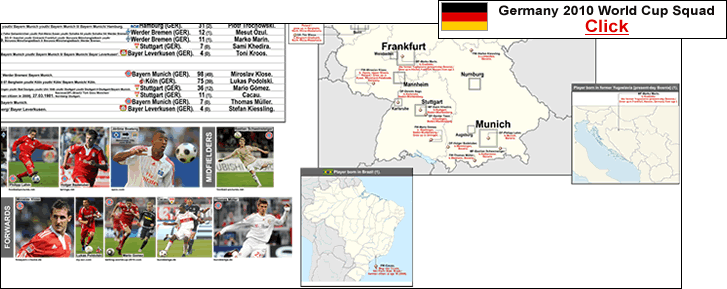
Germany 2010 World Cup squad.
The map shows the birthplaces and hometowns of the players on the Germany national team that is competing in the 2010 World Cup in South Africa. At the bottom, left of the map page are photos of all the players in the German squad who have seen action in the first 5 matches in the competition (19 player photos). International appearances (aka caps) and international goals as of 3rd July, 2020 are listed.
-
From The Telegraph.co.uk, by Duncan White, Mesut Ozil at head of the vanguard for new generation (12 June, 2010).
These days, Germany fields an ethnically diverse squad. There are 5 players on the Germany squad who were born abroad. Three players were born in Soviet bloc-era Poland: starters Miroslav Klose and Lukas Podolski (both of Silesian heritage), and sub Piotr Trochowski. One player, midfielder Marko Marin, is a Bosnian Serb whose family fled war-torn Bosnia for Germany in 1991. One player, Cacau, is Brazilian-born and raised. He became a German citizen in 2009. While on the subject of players from abroad, it is worth mentioning that midfield wizard Mesut Özil is a third generation Turkish German. DF Serdar Tasci is also of Turkish origin. Starting midfielder Sami Khedira is a Tunisian-German. DF Jérôme Boateng is of Ghanian-German descent. And DF Dennis Aogo is of partly Nigerian descent.
-
Thanks to the contributors to the pages at en.wikipedia.org, Germany national football team. Thanks to UK Soccer Shop.com, for the photos of the Germany jerseys.
June 17, 2010
2010 FIFA World Cup: Brazil, 23-man roster.
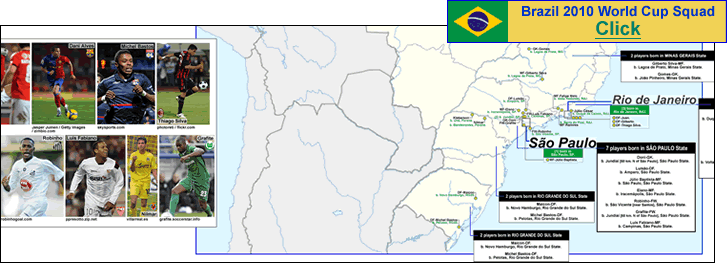
Brazil 2010 World Cup squad.
The map shows the birthplaces of the 23-man Brazil team competing in the 2010 World Cup in South Africa. At the lower left of the map page are photos of likely starters and key subs (18 player photos). Because of the Brazilian custom of giving players nicknames (which often bear little or no resemblance to their given names), I have listed the player’s full given name on the far left, with the common currency nickname in darker letters.
…
Brazil is a federation comprised of 26 States and one Federal District. Brazil is the fifth largest country in the world, both in geographical terms and by population. Brazil’s population is around 193 million {see this, ‘List of countries by population’ (en.wikipedia.org)}. Here is a list of largest cities in Brazil, {‘List of largset cities in Brazil‘}.
…
Seven States, and the Federal District, produced players in Brazil’s 2010 World Cup squad…
7 players were born in São Paulo State.
6 players were born in Rio de Janeiro State.
2 players were born in Minas Gerais State.
2 players were born in Brasilia, in the Federal District.
2 players were born in Minas Gerais State.
2 players were born in Paraná State.
1 player was born in Bahia State.
1 player was born in Pernambuco State.
…
20 of the 23 players in the squad play professionally in Europe (which, in football terms, includes Turkey). The other 3 play in Brazil…FW Robinho, who is actually still owned by an English club, Manchester City, but is on loan back to his original club, Santos FC (who are from the port city of Santos, which is about 54 km. (33 mi.) south of São Paulo); MF Kléberson, who plays for the most-supported Brazilian club, reigning champions Flamengo, of Rio de Janeiro; and DF Gilberto, who plays for Cruzeiro of Belo Horizonte, Minas Gerais.
…
Here is the breakdown of the 20 foreign-based players on the Brazil team…
8 players play in Italy, in Serie A.
4 players play in Spain, in La Liga.
2 players play in Germany, in Budesliga-1.
2 players play in Portugal, in Liga Sagres.
1 player plays in England, in the Premier League.
1 player plays in France, in Ligue Un.
1 player plays in Turkey, in Süper Lig.
1 player plays in Greece, in Super League.
-
Thanks to the contributors to the pages at en.wikipedia.org, Brazil national football team.
Thanks to UK Soccer Shop.co.uk, for the photos of the Brazil jerseys.
June 15, 2010
2010 FIFA World Cup: Spain, 23-man roster.
Note: if you want to see my latest post on Spanish 1st division football (aka La Liga), click on the following…http://billsportsmaps.com/?category_name=spain.
.
.
.
.
.
.
.
.
.
.
.
.
.
.
.
.
.
.
.
.
.
.
.
.
.
.
.
.
.
.
.
.
.
.
.
.
.
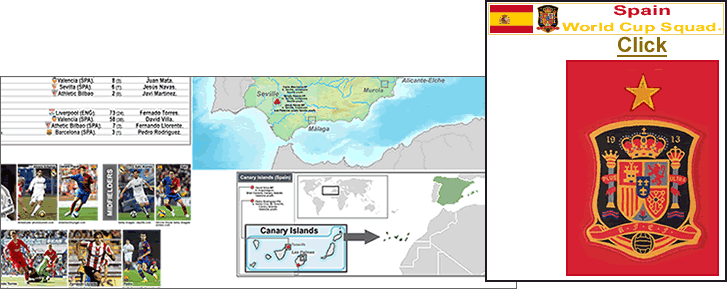
Spain 2010 World Cup squad.
The map shows the birthplaces of the players on the Spain national football team which played in South Africa for the 2010 FIFA World Cup. Spain went on to win their first World Cup title, defeating the Netherlands 1-0 in the final, with the winning goal scored by MF Andrés Iniesta in the 116th minute of AET.
At the bottom left of the map page are photos of all the Spain national team players who made appearances in the 2010 World Cup (20 player photos, all in the gear of each player’s professional club). International appearances (aka caps) and international goals are up to date as of 11th July, 2010 (that is, the close of the 2010 World Cup).
-
Professional clubs of the Spain squad…
In Spain:
FC Barcelona – 8 players.
Real Madrid CF – 5 players.
Valencia CF – 3 players.
Athletic Club [Bilbao] – 2 players.
Sevilla FC – 1 player.
Villarreal CF – 1 player.
In England:
Liverpool FC – 2 players.
Arsenal FC – 1 player.
-
From the Guardian.co.uk/The Knowledge, from 7 July, 2010, by John Ashdown, ‘ Are Spain the most one-club reliant team in World Cup history?‘.
-
Thanks to the contributors to the pages at en.wikipedia.org, Spain national football team.
Thanks to Demis.nl, for the base map of Spain. Thanks to UK Soccer Shop.com, for the Spain jerseys.
Thanks to DirtyTackle site, for the star-above-the-crest idea.
June 14, 2010
2010 FIFA World Cup: Côte d’Ivoire (aka Ivory Coast), 23-man roster.
…
Côte d’Ivoire 2010 World Cup squad.
…
The map shows the birthplaces of the 23-man squad of Côte d’Ivoire, which competed in the 2010 World Cup in South Africa. At the bottom of the map page are photos of projected starters and key subs (16 player photos). International appearances (aka caps) and international goals are listed and are up to date as of 25th June, 2010 (ie, when Ivory Coast exited the 2010 World Cup).
-
IvoryCoast.WorldCupBlog.org/.
-
2 players on the Ivory Coast roster were born in Europe, defender Sol Bamba, who was born in Paris, France (and plays professionally for Hibernian of Scotland); and defender Guy Demel, who was also born in Paris (and who plays for Hamburg of Germany).
I have shown the youth clubs of the players in two rectangles on the far right of the map page. 4 players attended youth acadamies in Europe (including Didier Drogba), and that is shown in the upper rectangle, with club logos (of Ligue 1 club Paris Saint-Germain, the Parisian fourth division amateur club Levallois SC, and the Belgian third division club KSK Beveren). Below that are listed the players who attended youth clubs/academies in the Ivory Coast, including the 13 players who were in the youth set-up of the Ivorian giants, ASEC Mimosas of Abidjan. [I showed all the logos I could find. I couldn't find logos of two tiny clubs, FC Bibo and CF d'Inter.]
13 players on the squad come from the largest city in the Ivory Coast, Abidjan. Abidjan has a population of around 3.8 million in the city and around 5.1 million in the metropolitan area {2006 figure}. Abidjan is the fourth-largest French-speaking city in the world, after Paris, France; Kinshasa, DR Congo; and Montreal, Canada. As a whole, Ivory Coast has a population of around 15.4 million {see populations of 2010 World Cup nations here, from The Best Eleven site}.
Two more players come from Greater Abidjan, from Anyama, which is 10 km. NE of Abidjan. Anyama-born players in the squad are DF Benjamin Angoura (of Valenciennes in France) and FW Gervinho (of Lille in France).
The north of the country is predominantly Muslim. The recently ended Civil War in the Ivory Coast was drawn largely along Christian versus Muslim lines, with the Republic stronghold in the south, and the rebel-held north {see this map}. Two players on the Ivory Coast squad came from the northern region, both born in the second-largest city in the country, Bouaké (population of around 770,000 {2002 census figure})…the Touré brothers, Kolo (of Manchester Cty) and Yaya (of FC Barcelona).
The capital of Côte d’Ivoire is the centrally-located Yamoussoukro, which has a population of around 200,000 {2005 figure}. Two players on the squad were born in Yamoussoukro, defender Cheik Tioté (of FC Twente in the Netherlands), and Seydou Doumbia, a young striker (who plays in Russia for CSKA Moscow).
Two players, FW Salomon Kalou (of Chelsea) and back-up GK Daniel Yeboah (of ASEC Mimosas) were born SW of Yamoussoukro.
-
Ivorian players in the 2010 Côte d’Ivoire World Cup squad, by locations of their current professional clubs…
In England, in the Premier League – 5 players.
In France, in Ligue Un – 4 players.
In Spain, in La Liga – 3 players.
In Germany, in Bundesliga-1 – 2 players.
In the Netherlansd, in the Eredivisie – 1 player.
In Russia, in the Russian Premier League – 1 player.
In Turkey, in Süper Lig – 1 player.
In Scotland, in the Scottish Premier League – 1 player.
In Romania, in Liga 1 – 1 player.
In Belgium, in the Belgian First Division – 1 player.
In Israel, in the Israeli Premier League – 1 player.
In Qatar, in the Qatar Stars League – 1 player.
In Côte d’Ivoire, in the Côte d’Ivoire Premier Division – 1 player.
-
Thanks to the contributors to the pages at en.wikipedia.org, Côte d’Ivoire national football team.
Thanks to official FIFA site, for caps and goals info, Côte dÍvoire Squad List.
June 13, 2010
2010 FIFA World Cup: Netherlands, 23-man roster.
Netherlands 2010 World Cup squad.
The map shows the birthplaces of the 23-man squad representing the Netherlands in the 2010 World Cup in South Africa. The Netherlands team made it all the way to the final, but fell just short, losing 1-0 to Spain in AET.
22 players on the Netherlands 2010 World Cup squad were born and raised in the home county of the Kingdom of the Netherlands. Young defender Edson Braafheid, who plays professionally for Bayern Munich, was born in South America, in the former Dutch possession of Suriname. Braafheid emigrated to the Netherlands (ie, Holland) when he was a youngster and played in youth set-ups in the Amsterdam and Utrecht areas, before joining the FC Utrecht youth academy.
At the bottom of the map page are photos of projected starters and key subs (20 player photos). International appearances (aka caps) and international goals are listed and are up to date as of 11th July, 2010 (that is, the close of the 2010 World Cup).
-
From The Guardian.co.uk, from 13 June, 2010, by Daniel Taylor: ‘World Cup 2010: Holland hope for harmony from their feuding stars‘.
-
Dutch players in the 2010 World Cup squad, by locations of their current professional clubs…
In the Netherlands, in the Eredivisie (9 players).
In Germany, in Bundesliga-1 (6 players).
In England, in the Premier League (5 players)
In Italy, in Serie A (2 players).
In Spain, in La Liga (1 player).
-
Thanks to the contributors to the pages at en.eikipedia.org. Netherlands national football team.
Thanks to Demis of the Netherlands, for the Netherlands base map and the Suriname base map. Demis.nl [homepage];
Demis Web Map Server.
June 11, 2010
2010 FIFA World Cup: Ghana, 23-man roster.

Ghana World Cup squad.
The map shows the 23-man Ghana team for the 2010 FIFA World Cup in South Africa. At the bottom left of the map page are photos of all the Ghana players who saw action in the 2010 World Cup (19 player photos).
From Guardian.co.uk/football/blog, by Jonathan Wilson on 30th June, 2010, ‘World Cup 2010: Ghana ready to fulfil their destiny…Denied a kick at the 1966 World Cup during their truly great years, the Black Stars are now aiming to put the rest of Africa to shame‘.
-
There were 3 players on the team born in Europe… André Ayew (born in Seclin, France), Kevin-Prince Boateng (born in West Berlin, West Germany), and Quincy Owusu-Obeyie (born in Amsterdam, Netherlands).
14 players were born in the capital and largest city in Ghana, Accra. Accra has a population of around 1.6 million in the city and around 2.9 million in the metropolitan area {2000 figure}. [Ghana itself has a population of around 23.8 million {2010 estimate}.]
In the main map section, with each player there is listed, along with their birth place, the players youth clubs in Ghana and where the player pursued his professional career (in most cases in western Europe, though a few players have played or are playing in the Middle East and the Arabian Peninsula).
3 players are playing professionally in Ghana right now: the two back-up goalkeepers – Daniel Adjei (Liberty Professionals), and Stephen Ahorlu (Heart of Lions); and DF Lee Addy (Bechelem Chelsea).
One player is playing in Egypt right now (DF Abdul Ayew, for Zamalek SC).
One player is playing in Qatar right now, MF Quincy Owus-Abeyie (Al-Sadd SC).
One player is playing in South Africa (young defender Jonathan Mensah, who is not to be confused with his teammate, the veteran defender John Mensah).
The players on the Ghana squad who are playing professionally in Europe right now are…
4 players -Italy: MF- Stephen Appiaah (Bologna), MF- Sulley Muntari (Internazionale), MF- Kwadwo Asamoah (Udinese), FW- Dominic Adiyah (AC Milan).
3 players – England: GK- Richard Kingson (Wigan Athletic, 75 caps), DF- John Paintsil (Fulham), MF- Kevin-Prince Boateng (Portsmouth).
3 players – Germany: DF- Hans Sarpei (Bayer Leverkusen), DF- Isaac Vorsah (Hoffenheim), FW- Prince Tagoe (Hoffenheim).
3 players – France: DF – John Mensah (Lyon, 62 caps), MF – André Ayew (the just-promoted Arles-Avignon), FW- Asamoah Gyan (Rennes).
1 player – Spain: MF- Derek Boateng (Getafe).
1 player – Netherlands, FW- Matthew Amoah (NAC Breda).
1 player – Norway, MF- Anthony Annan (Rosenborg).
1 player – Switzerland, DF- Samuel Inkoom (FC Basel).
Thanks to the contributors to the pages at en.wikipedia.org. Ghana national football team.
Thanks to World Soccer Shop.com, for the photos of the Ghana jerseys.
June 8, 2010
2010 FIFA World Cup: Argentina, 23-man roster.
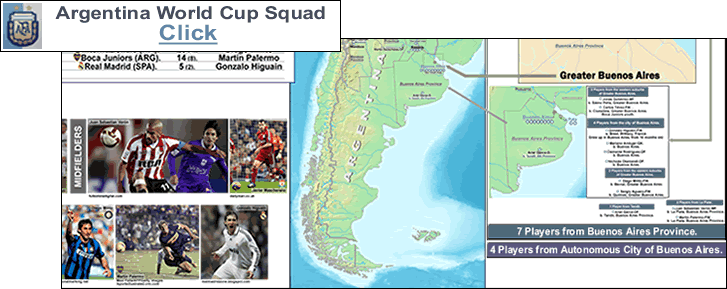
Argentina 2010 World Cup squad.
The map shows the birthplaces and/or the hometowns of the 23-man Argentina team that competed in the 2010 FIFA World Cup in South Africa. At the bottom, left on the map page are photos of all the players in the Argentina squad who saw action in their 5 matches in the competition (20 player photos, in the gear of their professional clubs). International appearances (aka caps) and international goals are listed in the chart section, and are up to date as of 3rd July, 2010.
-
The map page is a bit complicated, with separate sections for inset maps of two of the three largest cities in Argentina, Buenos Aires and Rosario, Santa Fe Province. Córdoba is the second largest city in Argentina, slightly larger than Rosario, but Córdoba has a far smaller influence than Rosario in footballing terms. For starters, there has been no first division club from Córdoba for three years now, and no Córdoba club has ever won the title. Meanwhile, Rosario boasts 9 Argentine titles…5 by Newell’s Old Boys and 4 by Rosario Central (and there is a third Santa Fe Province-based club in the top flight, Colón, from the city of Santa Fe, 130 km. north of Rosario).
…
Sprawling Buenos Aires has a metropolitan area population of around 12.9 million {2002 estimate}.
Rosario has a metropolitan area population of around 1.2 million {2001 census}), and is 270 kilometers (160 miles) NW of Buenos Aires.
…
The Buenos Aires section, on the far right of the map page, has a large map of Greater Buenos Aires that includes the city of La Plata, which is the capital city of Buenos Aires Province and is 59 km. (36 mi.) SE of the city of Buenos Aires. The Autonomous City of Buenos Aires is a separate entity in both legal and political terms, and is not part of Buenos Aires Province. [It's status is similar to that of Washington, DC (aka the District of Columbia), in the United States.] The Autonomous City of Buenos Aires, or Distrito Federal, is shown on the main map and the inset maps in a dark purple color.
…
15 of the current 20 first division clubs in the Argentine Primera División are located in the area comprising Greater Buenos Aires and neighboring La Plata. The breakdown is… 6 clubs from the Autonomous City of Buenos Aires (the current champions Argentinos Juniors, Boca Juniors, Huracán, River Plate, San Lorenzo, and Vélez Sarsfield); 1 club from the suburbs west of the City of Buenos Aires (Tigre); 6 clubs from the suburbs east of the City of Buenos Aires (Arsenal di Sarandi, Banfield, Independiente, Lanús, the just-promoted Quilmes, and Racing Club); and 2 clubs from La Plata (Estudianties and Gimnasia La Plata).
…
The city of La Plata has a population of around 690,000 {2001 census}. As mentioned, La Plata is home to 2 first division Argentine clubs…Estudiantes de La Plata, who are reigning Copa Libertadores champions and 4-time Argentine champions; and perennially relegation-threatened Gimnasia y Esgrima La Plata. The Argentina World Cup roster features two La Plata-born players, Juan Sebastián Verón (who captains Estudiantes) and Martín Palermo, the 36-year old Boca Juniors striker who had a 10 year exile from the national team before being recalled by Argentina coach Diego Maradona, in South American World Cup qualifiers in 2009. Palermo famously scored the 93rd minute winning goal versus Peru in October 2009, which kept Argentina from being eliminated from World Cup qualification.
…
8 players on the Argentina squad were born and/or grew up in Greater Buenos Aires, or Gran Buenos Aires…
Two players came from the western suburbs (Zona Oeste), striker Carlos Tévez and defensive midfielder Jonás Gutiérrez. Both these players play in England professionally, Tévez with Manchester City, and Gutiérrez with Newcastle United.
Four players on the squad came from the City of Buenos Aires. 3 were born and raised there: subs Mariano Andújar (goalkeeper for Catania of Italy) and Clemente Rodríguez (defender for Estudiantes), and projected starter Nicholás Otamendi, the young central defender who was instrumental in Vélez Sarsfield winning the 2009 Clausura title, and who was sold yesterday [Monday, June 7] to AC Milan.
The other City of Buenos Aires-raised player on the national squad is Real Madrid goal machine Gonzalo Higuaín, who was born in Brest, France (where his father played professionally), but moved with his family back to Argentina when he was 10 months old.
There are two players on the squad who were born in the southern suburbs of Greater Buenos Aires (Zona Sur), in the Quilmes partido: forwards Sergio Agüero (of Atlético Madrid), and Diego Milito (of Internazionale). Milito scored both goals in Inter’s UEFA Champions League victory over Bayern Munich in late May. Both these players are expected to see action in South Africa [note: who knows what the starting lineup will look like, because Diego Maradona's selections have defied conventional wisdom, if not basic logic, to say the least].
…
There are 10 players on the 23-man World Cup roster who were born and/or grew up in Greater Buenos Aires/La Plata. There is one more player from Buenos Aires Province, defender Ariel Garcé, who plays for Colón and is from Tandil, which is in south central Buenos Aires Province 360 kilometers (220 miles) SSW of the city of Buenos Aires. [There is one top flight club from southern Buenos Aires Province, the just-promoted Olimpo, from Bahía Blanca, which is 569 km. (353 miles) south of Buenos Aires.]
-
The Rosario inset map section is in the grey rectangle at the top of the map page, and includes an outline map of it’s province, Santa Fe. Five players were born in Santa Fe Province, three in Rosario, including the planet’s best football player, Lionel Messi. Messi moved with his family to Barcelona, Spain, when he was 13 years old. Lionel Messi suffered from a rare hormonal problem that could only be alleviated by very expensive injections of a growth hormone… at a price (of around $900 per month) that his original club, Newell’s Old Boys, balked at paying. So when FC Barcelona offered to pay for the injections, the Messi family moved to Barcelona, and Lionel Messi became part of the FC Barcelona set-up, where he remains to this day. Messi has never returned to visit his first club, Newell’s Old Boys, and the Newell’s top brass claim they intended on continuing to pay for Messi’s injections (but receipts prove otherwise).
…
The other two Rosario-born players on the squad are Maxi Rodríguez and Ángel Di María. Rodríguez is an attacking midfielder who now plays for Liverpool, and who scored a spectacular winning goal from a left-footed-volley in the 98th minute of Argentina’s 2006 World Cup second round match versus Mexico. Ángel Di María is a talented young playmaker who is expected to start in midfield, and plays for Portuguese giants Benfica.
…
The other two players who come from Santa Fe Province are both slated to start for Argentina in South Africa: captain and defensive midfielder Javier Mascherano (also of Liverpool), and Internazionale defender Walter Samuel.
-
In total, 6 of the 23 Argentine provinces, plus the Distrito Federal, (or City of Buenos Aires) produced players on the 2010 World Cup squad. Besides the 11 players from the Buenos Aires City-and-Province, and the 5 players from Santa Fe Province, there are 4 more provinces that produced players on the squad…Córdoba Province, Entre Rios Province, Mendoza Province, and Misiones Province. To give you an idea of how little of a part these provinces play in the Argentine football scene, there is only one current first division club from these four provinces, and that is Godoy Cruz of Mendoza (who actually fared surprisingly well last campaign, finishing in third).
…
Córdoba Province produced 4 players, while one player each came from the provinces of Entre Rios (Marseille defender Gabriel Heinze), Mendoza (Colón goalkeeper Diego Pozo), and Misiones (AZ Alkmaar goalkeeper Sergio Romero, who is slated to start in South Africa).
Córdoba and Enter Rios provinces, along with Santa Fe Province, form the economic region known the Center Region.
Mendoza Province is in an arid region in the far west of Argentina at the foothills of the Andes Mountains and is closer to Santiago, Chile than Buenos Aires.
Misiones Province is a jungle-filled panhandle surrounded by Paraguay and Brazil, and is the site of the world’s largest waterfall by volume, at Iguazu Falls.
Córdoba Province features the aforementioned city of Córdoba (1.5 million population {2008 estimate}), and just north of that is the salt lake known as Mar Chiquita, where two squad players came from (Bolatti and Burdisso). The four Córdoba Province-born players all play professionally in Europe…Bayern Munich defender Martín Demichelis (a projected starter), and three who play in Italy: AS Roma defender Nicholás Burdisso, Palermo midfield wizard Javier Pastore, and Fiorentina midfielder Mario Bolatti. The last two, Pastore and Bolatti, both made their mark leading the medium-sized club Huracán to the brink of the 2009 Apertura title (they lost it to Vélez Sarsfield on the final day).
Thanks to the contributors to the pages at en.wikipedia.org, Argentina national football team.
Thanks to Fans Edge.com, for the photos of the Argentina jerseys.
Thanks to Zimbio.com, for several of the player photos.
Thanks to Demis of the Netherlands, for the Argentina and Rosario base maps, Demis Web Map Server.
Thanks to Sam Kelly, at Hasta El Gol Siempre site, for fact-checking and proof-reading, and for information on players.
